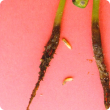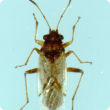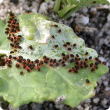Crops
The Department of Primary Industries and Regional Development continues to support the growth and international competitiveness of all crop industries in Western Australia.
With a 2400 kilometre span from its tropical north to its temperate south, WA supports a broad range of cropping industries from rain-fed winter cereals through to irrigated horticultural crops.
In the 2012/13 year the WA cropping industries exported a total of $3.9 billion which comprised: $3.1 billion of cereals, $859 million of pulses, pastures and oilseeds, $142 million of horticultural crops. The major contributors to these exports were wheat ($2.7 billion), canola ($756 million), barley ($377 million), lupins ($42 million), carrots at $48 million, oats ($12 million), and strawberries at $5.5 million.
Filter by search
Filter by topic
- Pests, weeds & diseases (42) Apply Pests, weeds & diseases filter
- (-) Remove Grains filter Grains
- (-) Remove Pest insects filter Pest insects
- (-) Remove Pests filter Pests
- Canola (18) Apply Canola filter
- Lupins (8) Apply Lupins filter
- Grains research & development (7) Apply Grains research & development filter
- Wheat (5) Apply Wheat filter
- Diseases (5) Apply Diseases filter
- Barley (5) Apply Barley filter
- Crop diseases (5) Apply Crop diseases filter
- Pulses (4) Apply Pulses filter
- Control methods (3) Apply Control methods filter
- Insecticides (2) Apply Insecticides filter
- Production & postharvest (2) Apply Production & postharvest filter
- Weeds (2) Apply Weeds filter
- Oats (2) Apply Oats filter
- Field peas (2) Apply Field peas filter
- Chemicals (2) Apply Chemicals filter
- Biosecurity & quarantine (2) Apply Biosecurity & quarantine filter
- Crop weeds (2) Apply Crop weeds filter
- Plant biosecurity (1) Apply Plant biosecurity filter
- Nematodes (1) Apply Nematodes filter
- Plant nutrition (1) Apply Plant nutrition filter
- Soils (1) Apply Soils filter
- Viruses & virus-like (1) Apply Viruses & virus-like filter
- Mechanical, physical and cultural (1) Apply Mechanical, physical and cultural filter
- Quarantine (1) Apply Quarantine filter
- Pome fruit (1) Apply Pome fruit filter
- Grapes & wine (1) Apply Grapes & wine filter
- Climate, land & water (1) Apply Climate, land & water filter
- Biosecurity (1) Apply Biosecurity filter
- Exporting from Western Australia (1) Apply Exporting from Western Australia filter
- Fruit (1) Apply Fruit filter
- Harvesting (1) Apply Harvesting filter
- Fungi (1) Apply Fungi filter
- Horticulture (1) Apply Horticulture filter













